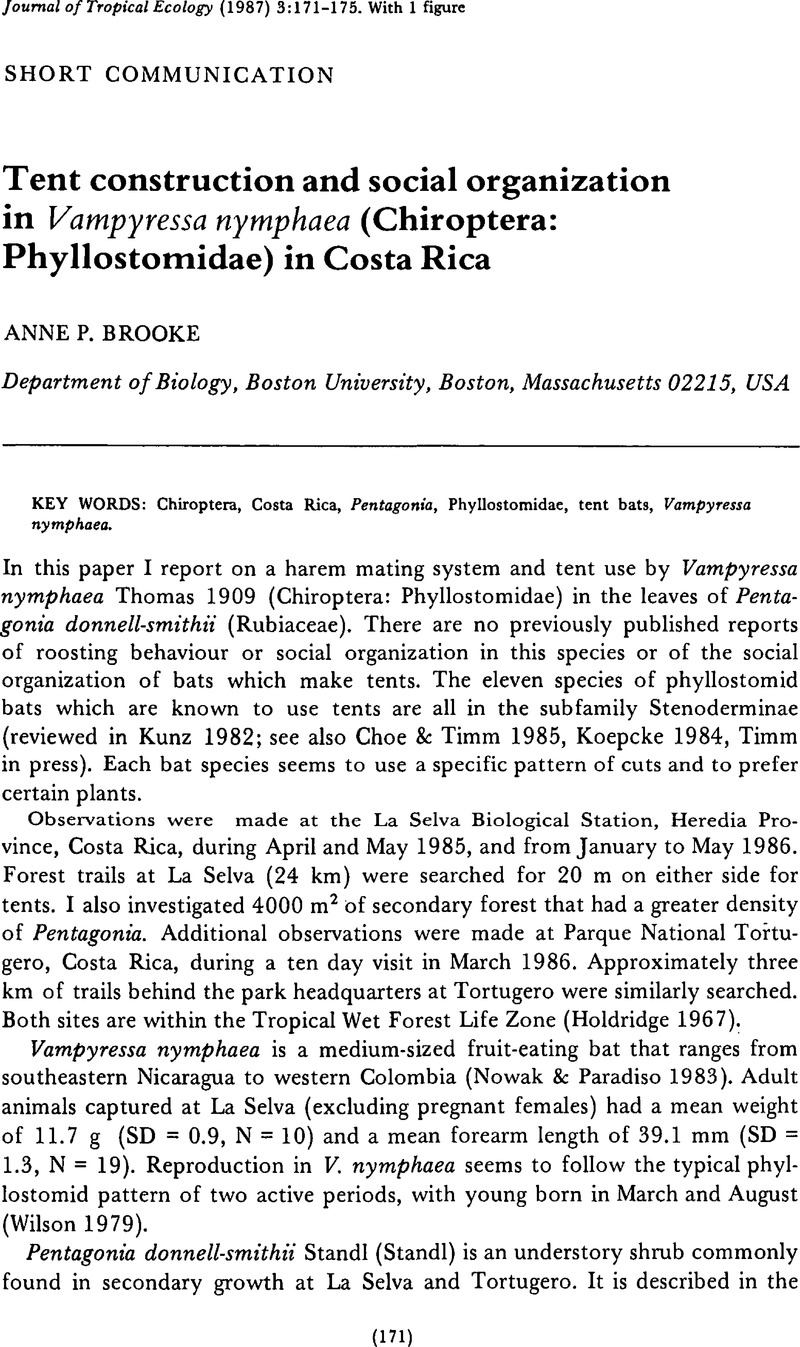Crossref Citations
This article has been cited by the following publications. This list is generated based on data provided by Crossref.
Rickart, Eric A.
Heideman, Paul D.
and
Utzurrum, Ruth C. B.
1989.
Tent-roosting by Scotophilus kuhlii (Chiroptera: Vespertilionidae) in the Philippines.
Journal of Tropical Ecology,
Vol. 5,
Issue. 4,
p.
433.
Brooke, Anne P.
1990.
Tent selection, roosting ecology and social organization of the tent‐making bat, Ectophylla alba, in Costa Rica.
Journal of Zoology,
Vol. 221,
Issue. 1,
p.
11.
Kunz, Thomas H.
Fujita, Marty S.
Brooke, Anne P.
and
McCracken, Gary F.
1994.
Convergence in tent architecture and tent-making behavior among neotropical and paleotropical bats.
Journal of Mammalian Evolution,
Vol. 2,
Issue. 1,
p.
57.
Balasingh, J.
Koilraj, John
and
Kunz, Thomas H.
1995.
Tent Construction by the Short‐nosed Fruit Bat Cynopterus sphinx (Chiroptera: Pteropodidae) in Southern India.
Ethology,
Vol. 100,
Issue. 3,
p.
210.
Kunz, Thomas H.
and
McCracken, Gary F.
1996.
Tents and harems: apparent defence of foliage roosts by tent-making bats.
Journal of Tropical Ecology,
Vol. 12,
Issue. 1,
p.
121.
Choe, Jae Chun
1997.
A new tent roost of Thomas’ fruit‐eating bat,artibeus watsoni(chiroptera: Phyllostomidae), in panama.
Korean Journal of Biological Sciences,
Vol. 1,
Issue. 2,
p.
313.
Tan, K.H.
Zubaid, A.
and
Kunz, T.H.
1997.
Tent construction and social organization inCynopterus brachyotis(Muller) (Chiroptera: Pteropodidae) in Peninsular Malaysia.
Journal of Natural History,
Vol. 31,
Issue. 11,
p.
1605.
Schulz, M.
2000.
Roosts used by the golden‐tipped bat Kerivoula papuensis (Chiroptera: Vespertilionidae).
Journal of Zoology,
Vol. 250,
Issue. 4,
p.
467.
McCracken, Gary F.
and
Wilkinson, Gerald S.
2000.
Reproductive Biology of Bats.
p.
321.
CHOLEWA, EWA
VONHOF, MAARTEN J.
BOUCHARD, SYLVIE
PETERSON, CAROL A.
and
FENTON, BROCK
2001.
The pathways of water movement in leaves modified into tents by bats.
Biological Journal of the Linnean Society,
Vol. 72,
Issue. 2,
p.
179.
Gopukumar, N.
Karuppudurai, T.
Nathan, P. T.
Sripathi, K.
Arivarignan, G.
and
Balasingh, J.
2005.
SOLITARY ADULT MALES IN A POLYGYNOUS-MATING BAT (CYNOPTERUS SPHINX): A FORCED OPTION OR A STRATEGY?.
Journal of Mammalogy,
Vol. 86,
Issue. 2,
p.
281.
Chaverri, Gloriana
and
Kunz, Thomas H.
2006.
Roosting Ecology of the Tent‐Roosting Bat Artibeus watsoni (Chiroptera: Phyllostomidae) in Southwestern Costa Rica1.
Biotropica,
Vol. 38,
Issue. 1,
p.
77.
Karuppudurai, T.
Sripathi, K.
Gopukumar, N.
Elangovan, V.
and
Arivarignan, G.
2008.
Transition of nonharem male to harem male status in the short-nosed fruit bat Cynopterus sphinx.
Mammalian Biology,
Vol. 73,
Issue. 2,
p.
138.
Machado, Daniel A.
Mérida, Michel S.
and
Muñoz-Romo, Mariana
2008.
Use of leaves as roosts by the Gervais' fruit-eating bat, Artibeus cinereus (Phyllostomidae: Stenodermatinae) and proposed modifiability index.
Acta Chiropterologica,
Vol. 10,
Issue. 1,
p.
169.
Esbérard, CEL
and
Bergallo, HG
2010.
Biology of Vampyressa pusilla (Wagner) in Rio de Janeiro State, southeastern Brazil (Mammalia, Chiroptera, Phyllostomidae).
Brazilian Journal of Biology,
Vol. 70,
Issue. 2,
p.
367.
Sagot, Maria
and
Stevens, Richard D.
2012.
The Evolution of Group Stability and Roost Lifespan: Perspectives from Tent‐Roosting Bats.
Biotropica,
Vol. 44,
Issue. 1,
p.
90.
Hernández-Mijangos, L. Arturo
and
Medellín, Rodrigo A
2013.
Use of Tents by the Big Fruit-Eating BatArtibeus lituratus(Chiroptera: Phyllostomidae) in Chiapas, Mexico.
The Southwestern Naturalist,
Vol. 58,
Issue. 1,
p.
107.
Mahandran, Valliyappan
Murugan, Chinnaperamanoor Madhappan
and
Nathan, Parthasarathy Thiruchenthil
2018.
Effect of female group size on harem male roosting behavior of the Indian short-nosed fruit bat Cynopterus sphinx.
acta ethologica,
Vol. 21,
Issue. 1,
p.
43.
Rodríguez-Herrera, Bernal
Rodríguez, Melissa E.
and
Otárola, Mauricio Fernández
2018.
Ecological Networks between Tent-Roosting Bats (Phyllostomidae: Stenodermatinae) and the Plants Used in a Neotropical Rainforest.
Acta Chiropterologica,
Vol. 20,
Issue. 1,
p.
139.
Garbino, Guilherme S. T.
and
Tavares, Valéria da Cunha
2018.
Roosting ecology of Stenodermatinae bats (Phyllostomidae): evolution of foliage roosting and correlated phenotypes.
Mammal Review,
Vol. 48,
Issue. 2,
p.
75.





